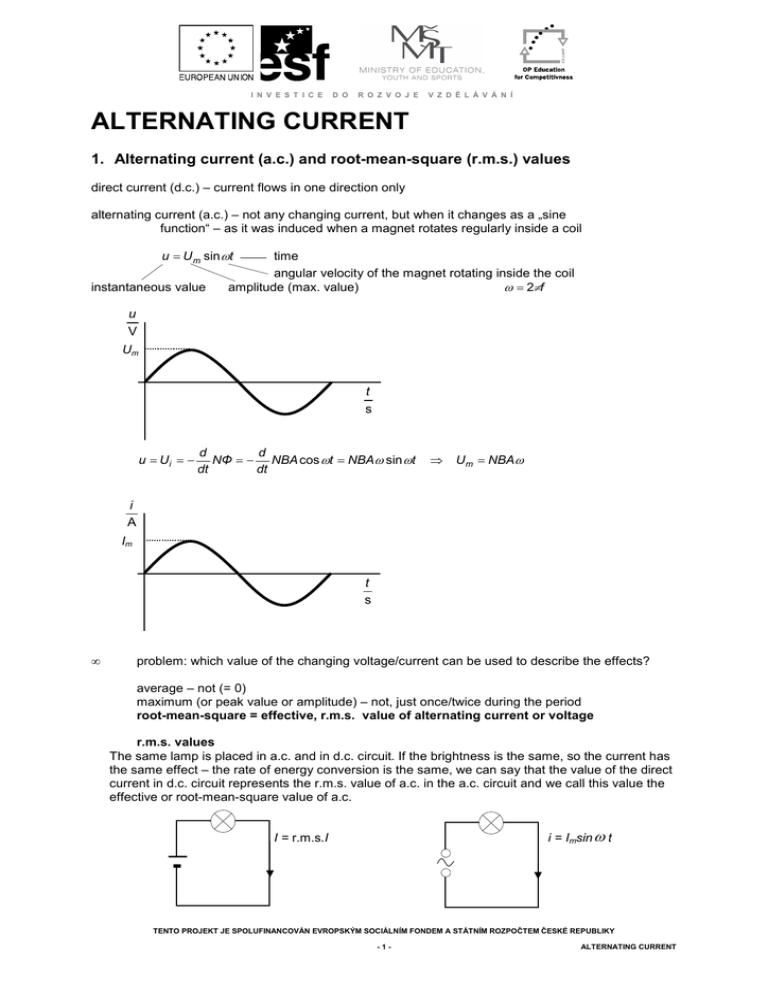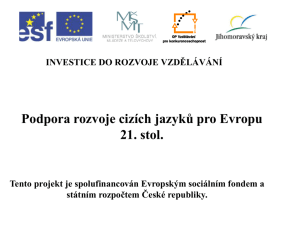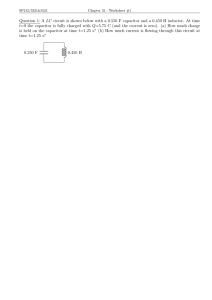ALTERNATING CURRENT
advertisement

I N V E S T I C E D O R O Z V O J E V Z D Ě L Á V Á N Í ALTERNATING CURRENT 1. Alternating current (a.c.) and root-mean-square (r.m.s.) values direct current (d.c.) – current flows in one direction only alternating current (a.c.) – not any changing current, but when it changes as a „sine function“ – as it was induced when a magnet rotates regularly inside a coil u = U m sin ωt instantaneous value time angular velocity of the magnet rotating inside the coil amplitude (max. value) ω = 2πf u V Um t s u = Ui = − d d NΦ = − NBA cos ωt = NBAω sin ωt dt dt ⇒ Um = NBAω i A Im t s • problem: which value of the changing voltage/current can be used to describe the effects? average – not (= 0) maximum (or peak value or amplitude) – not, just once/twice during the period root-mean-square = effective, r.m.s. value of alternating current or voltage r.m.s. values The same lamp is placed in a.c. and in d.c. circuit. If the brightness is the same, so the current has the same effect – the rate of energy conversion is the same, we can say that the value of the direct current in d.c. circuit represents the r.m.s. value of a.c. in the a.c. circuit and we call this value the effective or root-mean-square value of a.c. i = Imsin ω t I = r.m.s.I TENTO PROJEKT JE SPOLUFINANCOVÁN EVROPSKÝM SOCIÁLNÍM FONDEM A STÁTNÍM ROZPOČTEM ČESKÉ REPUBLIKY -1- ALTERNATING CURRENT I N V E S T I C E D O energy converted = power x time R O Z V O J E V Z D Ě L Á V Á N Í energy converted = power x time the same P = RI m2 sin 2 ωt P = UI = RI 2 = P area under P-t graph = energy i, p P = 21 Pm 2 RI 2 = 21 RI m I2 = 2 Im 2 t 2 Im = Ief ... r.m.s. value of i 2 2 U= U m = Uef ... r.m.s. value of u 2 I= Questions: 1. Is the value of 230 V in the socket the peak one or the r.m.s. one? Calculate the second value. 2. A.c. circuits i a) resistor in a.c. circuit u i= u Um = sin ωt = I m sin ωt R R u, i U Im = m R amplitude of voltage resistance amplitude of a.c. • t u and i are IN PHASE (max and min simultaneously) http://www.walter-fendt.de/ph14e/accircuit.htm b) capacitor in a.c. circuit i a capacitor must be charged before we can measure the voltage across it u the phase difference between the voltage and current is u = U m sin ωt i = I m sin(ωt + π 2 π 2 ) = I m cos ωt TENTO PROJEKT JE SPOLUFINANCOVÁN EVROPSKÝM SOCIÁLNÍM FONDEM A STÁTNÍM ROZPOČTEM ČESKÉ REPUBLIKY -2- ALTERNATING CURRENT I N V E S T I C E • XC = XC = D O R O Z V O J E resistance of a capacitor in a.c.c = capacitative reactance XC V Z D Ě L Á V Á N Í u, i [X C ] = Ω Um Im t 1 the capacitor is a bigger „obstacle“ to current when capacitance is small = it is ωC charged quickly or when the frequency is small (ω = 2πf ) c) inductor (coil) in a.c. circuit i an inductor forms a voltage against the changing current so the current is delayed the delay is u π 2 u, i u = U m sin ωt i = I m sin(ωt − • XL = π 2 ) = −Im cos ωt resistance of an inductor in a.c.c. = inductive reactance XL Um Im X L = ωL t [X L ] = Ω inductor is a bigger „obstacle“ to current when the coil has a big inductance and when the current changes quickly phasor diagrams phasor = a vector having the size of Um or Im which rotates with angular velocity ω = 2πf and its projection represents the instantaneous value of voltage or current resistor u,i t TENTO PROJEKT JE SPOLUFINANCOVÁN EVROPSKÝM SOCIÁLNÍM FONDEM A STÁTNÍM ROZPOČTEM ČESKÉ REPUBLIKY -3- ALTERNATING CURRENT I N V E S T I C E D O R O Z V O J E V Z D Ě L Á V Á N Í capacitor u,i t inductor u,i t d) RLC in series i the current is the same – in phase uL voltage differs (amplitudes, phase) u uR task – find the relation between them uC • phasor diagram u UL Im UR t UC 2 Um = U R2 + (U L − UC )2 Z 2Im2 = R 2Im2 + ( X L − X C )2 Im2 Z = R 2 + ( X L − XC )2 ... impedance = resistance of R,L and C in a series a.c. circuit TENTO PROJEKT JE SPOLUFINANCOVÁN EVROPSKÝM SOCIÁLNÍM FONDEM A STÁTNÍM ROZPOČTEM ČESKÉ REPUBLIKY -4- ALTERNATING CURRENT I N V E S T I C E D O R O Z V O J E V Z D Ě L Á V Á N Í [Z ] = Ω tan ϕ = U L − UC X L − X C = UR R • series resonance When XL=XC the voltages across the capacitor and inductor balance each other and it behaves as if there is only the resistor – maximum current passes. X L = XC ωL = 1 ωC 2πf0 L = 1 2πf0C f0 = 1 2π LC ... resonance frequency Questions: 2. A 1 mF capacitor is joined in series with a 2.5 V, 0.3 A bulb and a 50 Hz supply. Calculate the r.m.s. value of p.d. of the supply to light the lamp to its normal brightness and the r.m.s. values of p.ds across the capacitor and the bulb. 3. A 2 H inductor of resistance 80 Ω is connected in series with a 420 Ω resistor and 240 V, 50 Hz supply. Find the current in the circuit and the phase angle between the voltage and current in the circuit. 4. A circuit consists of an inductor of 0.2 mH and resistance 10 Ω in series with a variable capacitor and a 0.1 V (r.m.s.), 1 MHz supply. Calculate the capacitance to give resonance and the p.ds across the inductor and the capacitor at resonance. 5. Sketch a graph representing how resistance, inductive reactance, capacitative reactance and impedance change with frequency. L5/319-321, 323-339, 341-355, 367-372 e) parallel (R)LC circuit can be used in tuning circuits to choose a signal with a certain frequency (f0) aerial • function : The capacitor is charged („from outside“– sketch!) and then disconnected. If there were no coil, it would only be discharged in a very short time by a huge current. But if there is a coil, the current cannot rise quickly because of self-induction and it rises until the capacitor is discharged. Then the capacitor does not supply the current but it cannot stop immediately because of the coil. The capacitor is charged in the opposite direction and then discharged again – electrical oscillations are formed. Their period (time to get the capacitor charged again in the same polarity) depends on the inductance and capacitance. TENTO PROJEKT JE SPOLUFINANCOVÁN EVROPSKÝM SOCIÁLNÍM FONDEM A STÁTNÍM ROZPOČTEM ČESKÉ REPUBLIKY -5- ALTERNATING CURRENT I N V E S T I C E D O R O Z V O J E V Z D Ě L Á V Á N Í X L = XC ωL = 1 ωC 2πf0 L = 1 2πf0C f0 = 1 • resonance: These electrical oscillations are damped a lot (voltage and current gradually fall, frequency stays the same). To keep the oscillations energy must be supplied from outside. The most efficient way is when the frequency of the outer signal is the same as the natural one = resonance. This can be used in tuning circuits. We can change f0 changing the capacitance, inductance or in parallel RLC circuit the resistance. ... natural frequency 2π LC http://www.walter-fendt.de/ph14e/osccirc.htm L5/ 398-400,402-403, x404, 405 3. Power in a.c. circuits • a.c. circuit without inductor or capacitor See previous part r.m.s. values. When voltage is in phase with current 2 p = Ri 2 = RIm sin2 ωt = Pm2 sin2 ωt P = 21 Pm P = UI power in a.c.c r.m.s. current with resistors only r.m.s. voltage • a.c. circuit with inductor and/or capacitor Useful energy conversion (into heat, light...) takes place only on resistors. On capacitors and inductors the electrical energy supplied is converted only into an electric (on C) or magnetic (on L) field. This means that maximum efficiency is when there is zero phase angle. The bigger the phase angle, the lower the active power. P = UI cos ϕ = PS cos ϕ active power power factor apparent power (can be measured in unit VA) [P ] = W L5/374-379 Answers: 1. 325 V 2. 2.7 V; 0.96 V; 2.5 V ° 3. 0.3 A; 52 4. 0.13 nF; 13 V TENTO PROJEKT JE SPOLUFINANCOVÁN EVROPSKÝM SOCIÁLNÍM FONDEM A STÁTNÍM ROZPOČTEM ČESKÉ REPUBLIKY -6- ALTERNATING CURRENT




